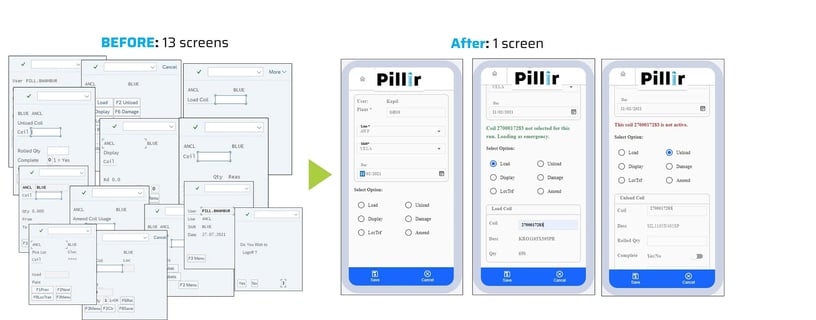A low-code legacy migration solution allows you to visualize technical debt and easily integrate business processes in your new IT environment.
The demand for legacy migration solutions is growing – and for good reason. Enterprises have little choice other than to undergo digital transformation. Operations that don’t streamline, automate, and enable real-time visibility will fall behind their competitors that do. In almost every case, digital transformation requires migrating IT systems to the cloud or modern on-premises system – which has benefits of its own. Built with SAP or other enterprise resource planning (ERP) solution at its core, a modern system is easier to maintain and secure and will perform better than the legacy environment, contributing to an even greater competitive advantage. Moreover, the shortage of resources and aging technologies with even scarcer resources are making it hard to keep current systems working and secured.
Legacy Application Migration Considerations
Even though enterprises understand that digital transformation is pivotal, there’s a common challenge that most must overcome. According to American SAP User Group (ASUG) and Pillir research, 91% of SAP users rely on one or more custom ABAP applications to manage unique processes or operations. These apps can make the transition to the cloud or modern on-premises environment more complicated, time-consuming, and, in some cases, impractical.
Organizations have a few choices when migrating custom legacy applications to a new platform.
- Starting from scratch and rebuilding the application is an option, albeit an unpopular one. Enterprises that have already invested thousands of dollars into custom code are unlikely to want to do it again.
- Businesses can also choose ABAP code remediation; however, the process of remapping code for use in a new IT environment takes time and resources. Furthermore, the result is an app that works exactly the way it did previously with little ROI on your investment.
Enterprises must also approach the project strategically for a successful migration that delivers the most value to the organization. First, you should consider whether all legacy custom code should make the transition. Custom ABAP apps may contain lines of code for features or functionality that are no longer necessary – or that a developer who has long since moved on had a rationale for adding. Unfortunately, this legacy code has a cost associated with it, i.e., “technical debt,” that you’ll carry over to your new platform if you don’t address it during legacy migration.
Additionally, you need to consider how much disruption legacy modernization could create, particularly if your production teams use these apps in their day-to-day workflows.
Finally, the best strategy is to keep both current and future needs in mind. Modernizing code not only improves current business function and increases IT efficiency, but it also eliminates the need to rewrite code before you can migrate to a new IT environment. Forward-thinking organizations also understand that the changes you make today should not create more technical debt and new “legacy” applications that you need to address when technology advances in the future.

Accelerated SAP App Modernization, Before and After
The Best Legacy Migration Solution for Your IT Environment
Once you have determined the scope of your legacy migration project, you need to find the best way to execute it. Some companies offer services that take you through the processes of moving to the cloud or a modern platform, including legacy application migration and data migration from legacy systems. Outsourcing to a third party means that your service provider (rather than your in-house team) does the heavy lifting during the project. However, turning the project over to a provider also means giving up some control. Furthermore, if you chose to keep your custom code tied to your core ERP system, your new IT environment may have as much technical debt and the same limited visibility into your code as you do now. And, of course, there is a cost for legacy migration solutions, which can be substantial.
Alternatively, you may attempt to deal with legacy migrations with legacy development processes. Only go this route if you can count on your IT team’s bandwidth and ability to adapt applications for good user experiences in your new IT environment. Also, prepare for a longer period to complete cloud migration so that developers have the time they need to remediate and refactor legacy applications.
Fortunately, there is another option: a low-code/no-code rapid application development (RAD) platform specifically designed to reduce technical debt. This solution allows you to keep work in-house to maintain oversight of each decision and overcome the legacy system migration challenges that create a burden for your development team.
Fast and Reliable Custom Application Migration to the Cloud
Pillir developed its RAD platform to solve the problem of modernizing legacy code, specifically ABAP code, and enabling enterprises to use it in any IT environment. Pillir’s platform includes the ABAP Diagnostic Tool that allows developers and stakeholders throughout the enterprise to visualize custom apps and discover technical debt. The tool calculates the cost of remediating the code as well as the cost of using it in a cloud environment. These insights allow your team to make an informed decision about migrating the app based on the total cost of ownership (TCO) and the impact that using the app could have on future upgrades and extensibility.
Pillir’s EdgeReady Cloud platform also includes the ABAP Modernizer, which gives developers an easy way to migrate custom objects to the cloud. With Pillir, developers can choose which objects to modernize, then mine the code and automatically convert major pieces of it to modern code that runs on the cloud, leaving the SAP core cleaner. Developers then use Pillir’s graphical interface to review code, ensure that mapping is accurate and that code doesn’t include outdated elements. At this stage, developers can also refactor the app with cloud-native or mobile-native features to improve user experiences in your new IT environment.
Pillir also makes workflow and business process management and integrations easy with graphical, drag-and-drop functionality, saving time and enabling employees with limited development experience to participate in creating the optimal modern IT environment for your operations.
Enterprises Are Ready for a Low Code-Solution
The challenge of legacy application migration has slowed progress toward digital transformation for far too long -- in some cases, even putting plans on hold for migration to new environments like SAP S/4 HANA that can provide your organization with new efficiencies and capabilities.
Final thoughts on Legacy Migration Solutions
Pillir is the only company in the market that can automatically convert your legacy ABAP code into modern, cloud-based mobile-friendly code. Learn more






 Back
Back/Logo%20-%20black%20text%20blue%20pillar%20(large)-1.jpg)

